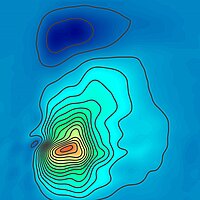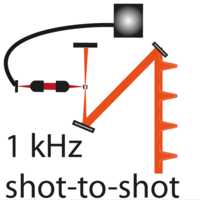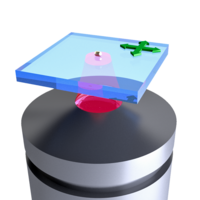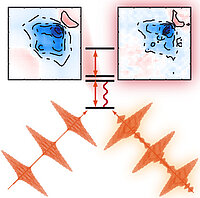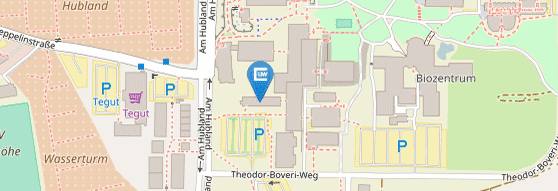Femtosecond technology
In our research projects we apply ultrashort laser pulses for various purposes. The general optical technologies for generating, handling, manipulating, and measuring ultrashort pulses are also being developed in our group.
The technology of Ti:Sapphire-based femtosecond oscillators and chirped pulse amplification (CPA) is well established and widely used. Commercial femtosecond oscillators and amplifiers can be used to generate near-infrared pulses around 800 nm. For a vast range of applications however, the required wavelengths are in the ultraviolet, visible or (mid-)infrared region of the electromagnetic spectrum. Therefore, frequency conversion of the fundamental laser is necessary. Nonlinear optical processes like sum- or difference-frequency generation are one route to ultrashort pulses at e.g. 400 nm or 267 nm. To access the visible and the infrared region, we employ optical parametric amplification (OPA), thus tunable pulses can be obtained and UV pulses can be generated by subsequent frequency mixing. The bandwidth of OPA is limited to a few tens of nanometers. For applications where the shortest possible pulses or the most broadband pulses are needed, we use OPA in the non-collinear geometry (NOPA). This allows an extremely broad amplification bandwidth over practically the whole visible spectrum. Another way to generate pulses with a very broadband visible spectrum is to use hollow-core fibers filled with a noble gas [1].
To generate the shortest pulses possible, not only a broad spectrum is important but also the phase of the pulse has to be controlled precisely. To compress ultrashort pulses, dispersion management is essential. Besides more or less static dispersion management elements like chirped mirrors, prism compressors, or phase masks, flexible pulse shaping technologies can be used to manipulate the spectral phase of the laser pulses and thus their temporal structure. In our lab, we were the among the first groups to develop and apply a pulse shaper setup that uses a zero dispersion compressor (4f-setup) and a computer-controlled variable mask, in our case a liquid crystal display (LCD), in the Fourier plane to manipulate the spectral phase of the laser pulses. A liquid crystal display allows for control over the spectral phase, amplitude and polarization of the pulses. Another variant of pulse shaping is based on the so-called acousto-optic effect, in which light field shaping occurs via interaction with an acoustic wave propagating in a birefringent crystal. Pulse shaping is a versatile method to not only compress pulses but also to create nearly arbitrary, well-defined temporal shapes. These can be used for a multitude of quantum control and spectroscopy experiments, such as coherent two-dimensional spectroscopy [2].
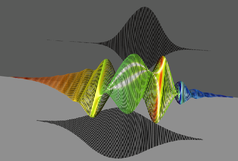
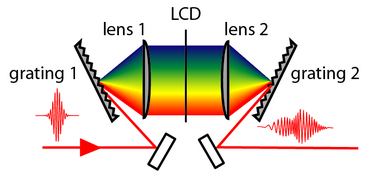
Polarization shaping makes use of the vectorial character of light and control over the polarization state of the laser is possible on a femtosecond timescale. This combination of ultrafast temporal with spatial resolution is used e.g. in our nano-optics projects. Furthermore, we can extend the possible range of applications for pulse shaping to the visible and the UV through the above mentioned methods of OPA and frequency mixing.
Since ultrashort pulses are among the shortest human-created phenomena, their exact characterization cannot be done with conventional electronics but requires other optical techniques. The most common one is frequency-resolved optical gating (FROG). For the calibration of pulse shapers as well as for the characterization of signal fields gained in experiments we also use spectral interferometry [3, 4].
In our lab, we employ, combine, and advance the techniques described above to introduce new applications and to gain physical and chemical insight, as well as active control over chemical reactions, through fundamental research.
References
| [1] | X. Ma, J. Dostál, and T. Brixner, In this paper, we demonstrate coherent two-dimensional spectroscopy with broadband excitation in the visible spectral region. The white light continuum is generated using an argon-filled hollow-core fiber and compressed to a pulse duration of 7 fs with chirped mirrors. |
| [2] | S. Draeger, S. Roeding, and T. Brixner, We describe here an experimental setup for coherent 2D spectroscopy with fluorescence detection, using an acousto-optic pulse shaper in shot-to-shot operation. |
| [3] | M. Pawłowska, S. Goetz, C. Dreher, M. Wurdack, E. Krauss, G. Razinskas, P. Geisler, B. Hecht, and T. Brixner, Here we present a pulse shaper-based setup, which we combine with a microscope objective to enable time-resolved spectroscopy with spatial resolution. We have also developed a novel method to characterize the spatio-temporal properties of the excitation pulses. |
| [4] | S. Pres, L. Kontschak, M. Hensen, and T. Brixner, In this article, we present a method to characterize the multipulse excitation fields used in coherent 2D spectroscopy in amplitude and phase. |


